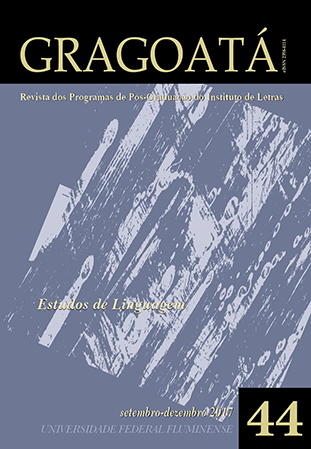Semiotics and Discourse Studies
DOI:
https://doi.org/10.22409/gragoata.v22i44.33548Palavras-chave:
Estudos do Discurso. Semiótica. Discurso acadêmico. Greimas.Resumo
In this paper, I would like to discuss the contribution that post-structuralist semiotics has brought to the analysis of academic discourse. The semiotic model was developed initially for the analysis of tales and myths. It has been gradually extended to various forms of fiction (novels, short stories), and then, according to "a growing degree of complexity and abstraction", to all "forms of social production of meaning" (p. 5). This is the project stated in the first pages to a book entitled “Introduction to Discourse Analysis in Social Sciences” (A.J. Greimas & E. Landowski eds, 1979). The generalized extension is based on a typology of discourses that has been illustrated by specific analyses published in the 1980s (Bastide 1981, Bastide & Fabbri 1985, Landowski 1986, Bordron 1987). One may be considered that the research project led by Greimas and Landowski is thus located at the farthest point of development and initial application of the model and it is therefore a test for the narrative hypothesis. In doing so, the semiotic approach took the risk of being confronted with other models of analysis, such as they were elaborated in theoretical frameworks resulting from rhetoric (renewed in the 1950s by Chaim Perelman and his school ), pragmatics (cf Parret 1983 & 1987), sociology of knowledge (from the founding work of Berger & Luckmann 1966), or as they relate to other theoretical currents in the language sciences (in particular, In France, the Althusserian discourse analysis). For the discourse in social sciences, these models offer two advantages over that of semiotics: on the one hand, it seems that the theoretical postulates on which they are worked out are more directly in accord with this type of discourse; on the other hand, they can count on a solid tradition of studies to ensure the sustainability of the results. Nevertheless, the model of semiotic analysis is original and it has also an advantage: it is general. I will put forward the benefits of this generality.
---------------------------------------------------------------------------------
Semiótica e Estudos do Discurso
Neste artigo, eu gostaria de discutir a contribuição que a semiótica pós-estruturalista deu à análise do discurso acadêmico. O modelo semiótico foi desenvolvido inicialmente para as análises de fábulas e mitos. Ele tem sido gradualmente estendido às várias formas de ficção (romances, contos) e, então, de acordo com “um grau de crescimento de complexidade e abstração”, para todas as “formas de produção social de sentido” (p. 5). Este é o projeto declarado nas primeiras páginas de um livro intitulado “Introdução à Análise do Discurso nas Ciências Sociais” (A. J. Greimas & E. Landowski (eds), 1979). A extensão generalizada toma como base uma tipologia de discursos que tem sido ilustrada por análises específicas publicadas nos anos 1980 (Bastide, 1981; Bastide & Fabbri, 1985; Landowski, 1986; Bordron, 1987). Pode-se considerar que o projeto de pesquisa liderado por Greimas e Landowski está então localizado no ponto mais distante do desenvolvimento e aplicação inicial do modelo e, portanto, é um teste para a hipótese narrativa. Ao fazê-lo, a abordagem semiótica correu o risco de ser confrontada com outros modelos de análises, tais como foram elaborados na perspectiva teórica resultante da retórica (renovado nos anos 1950 por Chaim Perelman e sua escola), da pragmática (cf. Parret, 1983 & 1987), da sociologia do conhecimento (pelo trabalho fundador de Berger & Luckmann, 1966), ou como elas se relacionam com outras correntes teóricas nas ciências da linguagem (em particular, na França, a análise do discurso althusseriana). Quanto ao discurso nas ciências sociais, esses modelos oferecem duas vantagens sobre a semiótica: por um lado, parece que os postulados teóricos nos quais são trabalhados estão diretamente de acordo com esse tipo de discurso; por outro lado, eles podem contar com uma sólida tradição dos estudos para garantir a sustentabilidade dos resultados. Mesmo assim, o modelo de análise semiótica é original e tem também uma vantagem: ela é geral. Apresentarei os benefícios dessa generalidade.
---
DOI: http://dx.doi.org/10.22409/gragoata.2017n44a1033
Downloads
Downloads
Publicado
Como Citar
Edição
Seção
Licença
AUTORIZAÇÃO
Autores que publicam em Gragoatá concordam com os seguintes termos:
Os autores mantêm os direitos e cedem à revista o direito à primeira publicação, simultaneamente submetido a uma licença Creative Commons Atribuição 4.0 Internacional (CC BY 4.0), que permite o compartilhamento por terceiros com a devida menção ao autor e à primeira publicação pela Gragoatá.
Os autores podem entrar em acordos contratuais adicionais e separados para a distribuição não exclusiva da versão publicada da obra (por exemplo, postá-la em um repositório institucional ou publicá-la em um livro), com o reconhecimento de sua publicação inicial na Gragoatá.
A Gragoatá utiliza uma Licença Creative Commons - Atribuição CC BY 4.0 Internacional.











